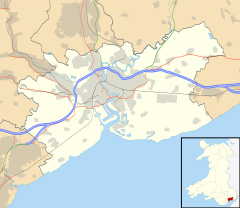Underwood, Newport
Underwood
|
|
|---|---|
| Underwood shown within Newport | |
| Population | 1,973 (2014 census) |
| Principal area | |
| Country | Wales |
| Sovereign state | United Kingdom |
| Post town | NEWPORT |
| Postcode district | NP18 2; NP26 3 |
| Dialling code | 01633 Llanwern and Penhow exchanges |
| Police | Gwent |
| Fire | South Wales |
| Ambulance | Welsh |
| EU Parliament | Wales |
| UK Parliament | |
Underwood is a community in the city of Newport, South East Wales. It is an early 1960s council housing estate that consists of houses, shops, a leisure centre, Baptist church and social club. The leisure centre is now up for sale.
The Underwood Estate was originally developed from the former World War II Prisoner of War camp after the end of the war. A few surviving examples of the former PoW huts were still visible until the early 1990s when they were demolished. The original huts stood as early community buildings. In the early 1980s several huts and a water tower were also visible on the now Waltwood Park Drive area, this area belonged to the General Post Office and was used to house old telecommunications equipment until it was sold and demolished by British Telecom who took over the site when BT was privatised in the early 1980s. The land was subsequently sold to Westbury homes who built the Waltwood Park Drive Development of around 220 houses on the land.
The estate is situated in a natural land formation within the falls of a wooded area on the south and north side and a small drainage ditch or reen called "Monks Ditch" on the northern side of the development. Built in three phases, with the Waltwood Park Development being the last of the three phases.
Many people believe that the Underwood Estate was created for the local steelworks at Llanwern, as it was constructed at the same time as the Richard Thomas and Baldwins "Spencer Works" was being built. This has some truth, as originally people moved into the huts after the war. However the local council at the time, Magor and St Mellons Rural District Council, created the housing estate with post-war initiatives for more housing, hence why the second phase of the housing development consists of rapid construction poured concrete houses which are very sturdy in construction and much stronger than traditional bricks-and-mortar houses.
...
Wikipedia

